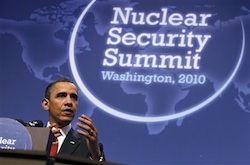Obama's Nuclear Spring
April 20, 2010
Featured Image
We are happy to serve you a daily summary of the top nuclear policy stories each morning, with excerpts from the stories in bullet form.
Stories we're following today, Tuesday, April 20, 2010:
Eight Days in April - Hendrik Hertzberg in the New Yorker [link]
- Earlier this month, in an eight-day whirl of public activity, the President demonstrated the seriousness of his Administration’s thoroughly post-Cold War approach to American nuclear-weapons policy. The central purpose of that policy is no longer to deter an attack from Russia or China. It is to galvanize an international effort to combat nuclear terrorism and nuclear proliferation.
- On April 6th, the Department of Defense released its Nuclear Posture Review, the first since 2002, which reduces the role of nuclear weapons in America’s national-security strategy.
- On April 8th, Obama was back in Prague, to join Dmitri Medvedev, the Russian President, in signing what is being called New Start. Under the treaty, which supersedes the old Starts, negotiated by Presidents Reagan and Bush the elder, both countries will reduce their strategic-warhead deployments by nearly a third and their launchers by half.
- Finally, on April 13th, Obama took the chair of a nuclear-security summit. [...] Its commonsense goal—which the previous Administration pursued somewhere between lackadaisically and not at all—was to persuade participating governments to “lock down” their bomb-usable nuclear material, much of which is stored in military, civilian, and university installations that are dangerously insecure.
- Obama’s nuclear spring will conclude in May, at a U.N. session aimed at strengthening the Non-Proliferation Treaty, which the President has made the organizing principle of his new nuclear strategy.
- All these steps fulfilled promises that Obama made in Prague a year ago.
- [Obama's] consistent, well-coördinated nuclear diplomacy is beginning to bear fruit.
Past Time to Recognize Nuclear Terrorism as Threat - Sen. Bob Casey in the Pocono Record [link]
- This week, the United States hosted a historic summit in Washington to address the threat of nuclear terrorism. This long overdue gathering addressed the most critical threat to U.S. national security and was an important first step toward the president's goal of securing all vulnerable nuclear material around the world within four years.
- In 1961, President Kennedy said that, "Every man, woman and child lives under a nuclear sword of Damocles, hanging by the slenderest of threads, capable of being cut at any moment by accident or miscalculation or by madness." President Obama noted that we are paradoxically more vulnerable today to a nuclear attack than we were during the Cold War. Today's sword of Damocles still hangs by the slenderest of threads but we have the ability to prevent this threat by minimizing the access that terrorists would have to nuclear material.
Iran, Sanctions and the Memo - New York Times Editorial [link]
- Sometime this spring, but still months later than President Obama predicted, Iran may finally face new United Nations sanctions for its illicit nuclear program.
- Mr. Obama has done a lot to prepare the ground. He has bolstered American credibility with his — since rebuffed — offer to engage with Iran. He signed a new arms reduction treaty with Russia, improved relations with China and is personally lobbying other United Nations Security Council members to support stronger sanctions.
- We don’t know if there is any mixture of pressure — or inducements — that will force Iran to abandon its nuclear ambitions. That’s what makes a memo written earlier this year by Defense Secretary Robert Gates and reported by The Times on Sunday so important.
- Looking beyond the current maneuvering, he raises some very disturbing and difficult questions that need to be addressed. How will the world contain Iran if it actually produces a weapon? What will Washington and its allies do if Iran acquires all of the parts but decides to stop just short of that?
- As for the military options under review, we are sure that an attack would be a disaster. We urge anyone who has doubts to listen closely to Adm. Mike Mullen, the chairman of the Joint Chiefs of Staff. He told reporters on Sunday that while military “options would cause delay” to Iran’s nuclear program, “that doesn’t mean the problem is going to go away.”
North Korea Readying For 3rd Nuclear Test: Report - Reuters [link]
- North Korea is preparing for a third atomic test that may come in May or June, South Korean broadcaster YTN reported on Tuesday, an act that could further isolate Pyongyang and complicate already troubled nuclear diplomacy.
- The preparations began in February and involve a level of technical proficiency that is significantly upgraded from the first two tests, considered partial successes at best, YTN quoted an unnamed diplomat as saying.
- Destitute North Korea may be trying to hedge its position, experts said. It needs the aid that comes with making progress in nuclear disarmament talks but also wants the world know it can rattle the region with another nuclear test if discussions fail.
At Los Alamos, Working Against Their Own Creation - NPR [link]
- America's first atomic bomb was made at the Los Alamos National Laboratory in New Mexico, and for decades the work there centered on designing nuclear weapons.
- But quietly, for years, some at Los Alamos have puzzled over ways to stop the spread of nuclear weapons.
- The expertise of those who built America's nuclear arsenal is put to use finding ways to stop the spread of nuclear weapons.
- Los Alamos has trained some 5,000 inspectors for the IAEA over 30 years. They've come from more than 40 countries, according to David Bracken, a former deputy group leader. "Every country that has sent someone to the agency as an inspector, we've [trained] them," he says.



